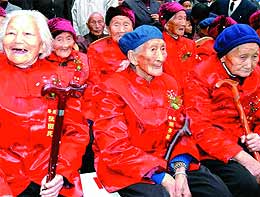
Under the planned economy, the Chinese government took care of old-age pension, medical service and other welfare of all civil servants, and staff and workers of enterprises and institutions. If anyone was employed by a state enterprise or institution, one would be taken care of all one's life, although it was a low-level security system. As China has become an aging society, the number of retirees is increasing, and some enterprises and institutions have more retirees than people on their pay-roll, resulting in great burdens and troubles to the enterprises and institutions. Since the 1990s, China has actively promoted the reform of the old-age, unemployment and medical insurance systems; and the State Council has promulgated the Regulations on Unemployment Insurance, the Interim Regulations on the Collection of Social Insurance Premium, and the Regulations on Guaranteeing Urban Residents' Minimum Standard of Living, providing legal guarantee for the implementation of the social security system. Now a social security system integrating old-age, unemployment, medical insurance and minimum standard of living has taken initial shape, which is separated from enterprises and institutions and managed by social forces.
—Old-age Insurance. The coverage of basic old-age insurance has constantly expanded from state- and collective-owned enterprises to enterprises of various types and institutions administered along the lines of an enterprise. The security rights and interests of employees at non-state enterprises are also guaranteed. At the end of 2002, a total of 111.29 million staff members and workers, and 36.08 million retirees in China had participated in the basic old-age insurance program.
—Medical Insurance. The basic medical insurance has covered various kinds of enterprises and institutions, and state organs and social organizations in cities and towns, being one of the social insurance systems with the widest coverage. By the end of 2002, 94.01 million people had participated in basic medical insurance.
—Unemployment Insurance. With a large population, China is under great employment pressure. To alleviate the employment problem, starting from 1993 the Chinese government has carried out the labor market policy, opening various channels for employment. In view of the fact that staff members and workers in state-owned enterprises have been laid off in the past few years during the industrial restructuring, the Chinese government has implemented a re-employment project. At the end of 2002 the number of employees in the urban areas reached 247.80 million. Since 1998, more than 18 million workers laid off from state-owned enterprises have been re-employed through various channels. At the end of 2002, the registered unemployment rate in the urban areas was four percent. Various institutions have adopted the unemployment insurance system, promoting the rational flow of workers and the formation of a unified labor market. By the end of 2002, a total of 101.82 million people had participated in the unemployment insurance program, and there were 4.4 million people drawing unemployment insurance money.
—Minimum Standard of Living Guaranteed. A minimum standard of living system has been established in all cities and county towns, providing a basic guarantee for urban residents whose family's per capita income is below the lowest local standard. In 2002, there were 20.54 million urban residents drawing money for a minimum standard of living. In the countryside, many areas began to establish the system for a minimum standard of living.

